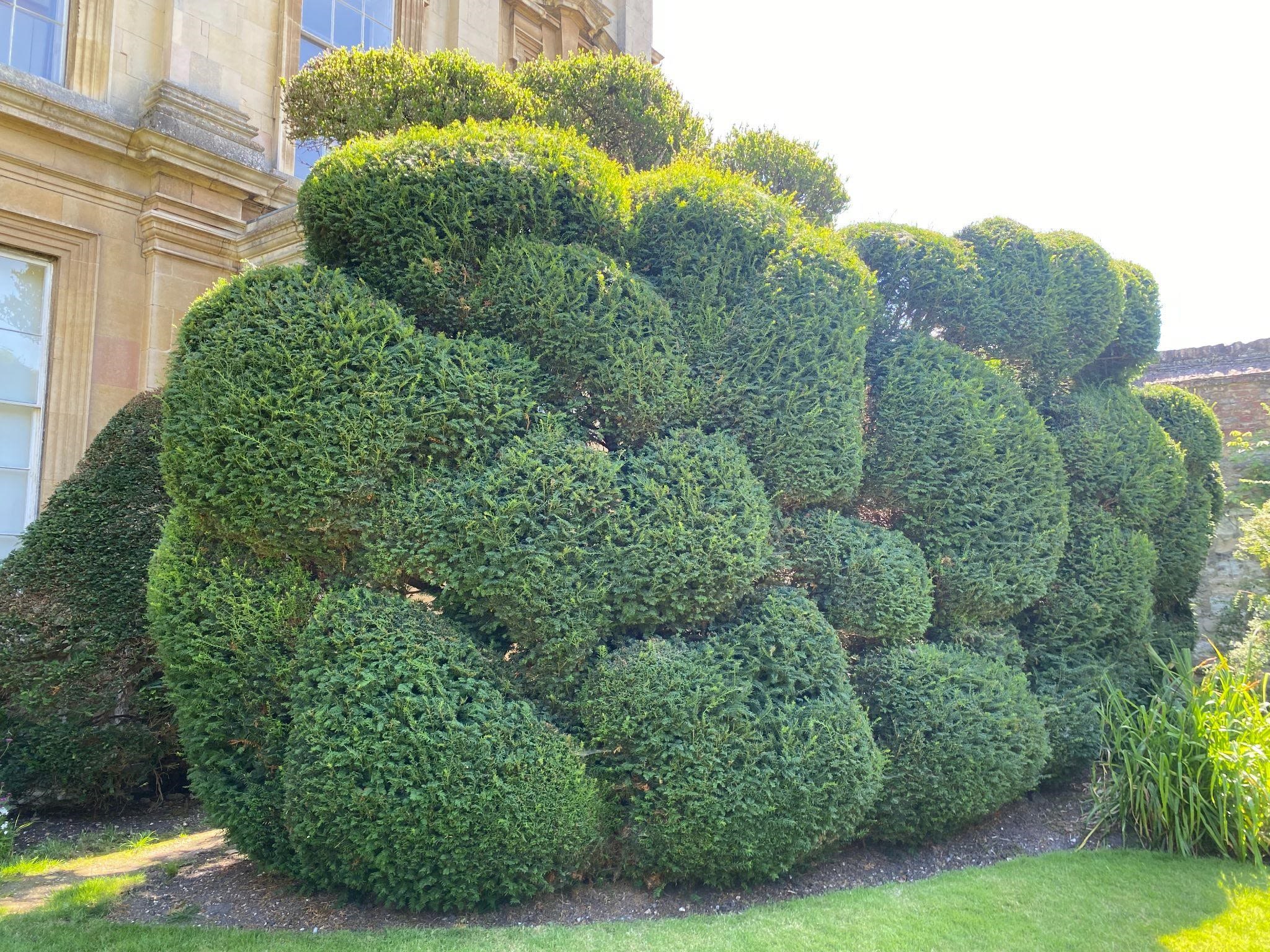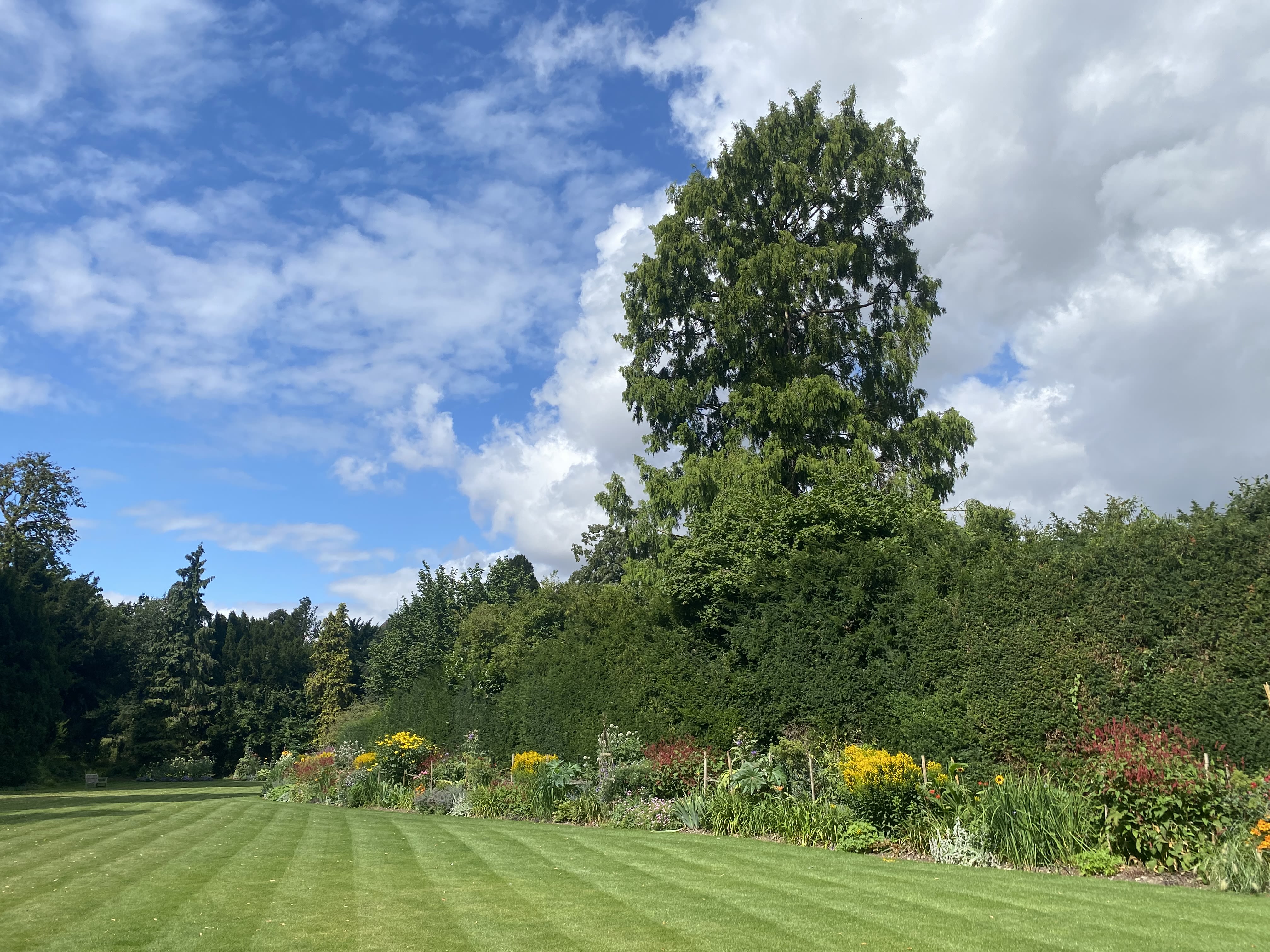Welcome to Clare College Gardens
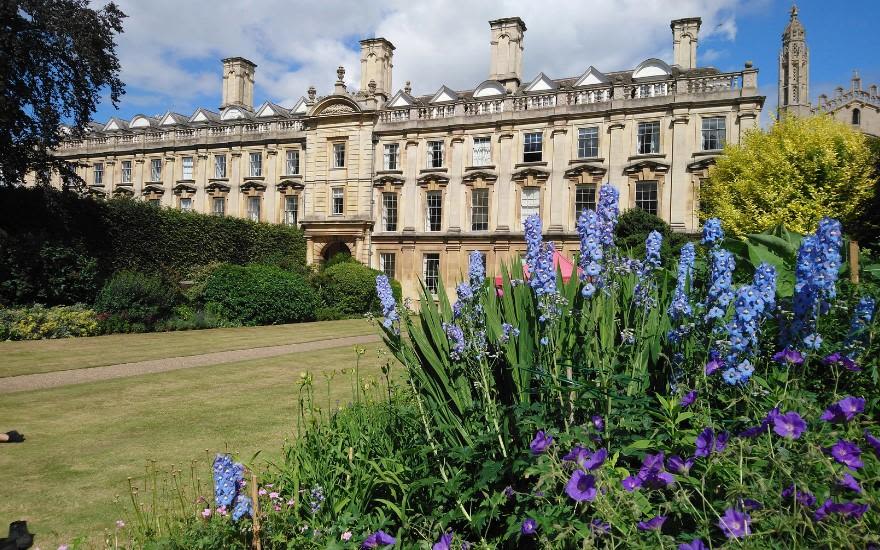

Welcome
Welcome to Clare College Gardens. Established circa 1947, the gardens were left to fallow during WWII, so in 1946 the great clear up and redesign of Professor Nevill Willmer was implemented. For the most part the gardens remain in the same layout and horticultural principals as set out by Willmer.
After being closed for 4 years due to the pandemic, followed by the River Room Café building works, we are excited to open up for use by the College community again! Keep checking the various bulletin boards/website for opening hours as these change through the year. The gardens will be open from Easter weekend from 9am - 7pm. As you enjoy the garden, scan the QR codes you see along the way to learn more about the garden, its history, and our approaches to gardening at Clare.
The gardens are a place of study and quiet contemplation. Please follow these simple rules to keep it enjoyable for everyone:
- No food or drink in gardens, except the river bank and the Scholars Garden
- No radios, wireless speakers, amplified music or streaming devices anywhere in the gardens
- No ball games or frisbees
Seasonal interest: The long, meandering herbaceous border of the Mixed Border is at it's best this time of year, packed to the brim and bursting with all the colours of the rainbow.
Take a walk through the River Beds Dry Border and see how well the drought tolerant planting scheme is performing - it hasn't been watered since it was planted in May 2024!
The Tropical Garden was planted at the beginning of June and it's a delight to see it develop through the summer months into a lush paradise hidden away in the middle of the Fellows' Garden.
Wildlife in the gardens: Many garden birds can be spotted around the gardens and you may catch a glimpse of Vlad (the Impaler), the Heron fishing in the pond, or Kenny, the Kingfisher hanging out in an apple tree, or even a red fox nonchalantly sauntering past you. You’ll see plenty of bees, butterflies and other insects on your way round as well.
Sustainability: Sustainability goals focus on fostering biodiversity, recycling materials, and adapting our planting and gardening practices to work with our changing climate.
Our team: The gardens at Clare College are looked after by a team of 7 gardeners, 4 full-time, 2 part-time and one apprentice. Feel free to ask us any questions if you see us working in the grounds.
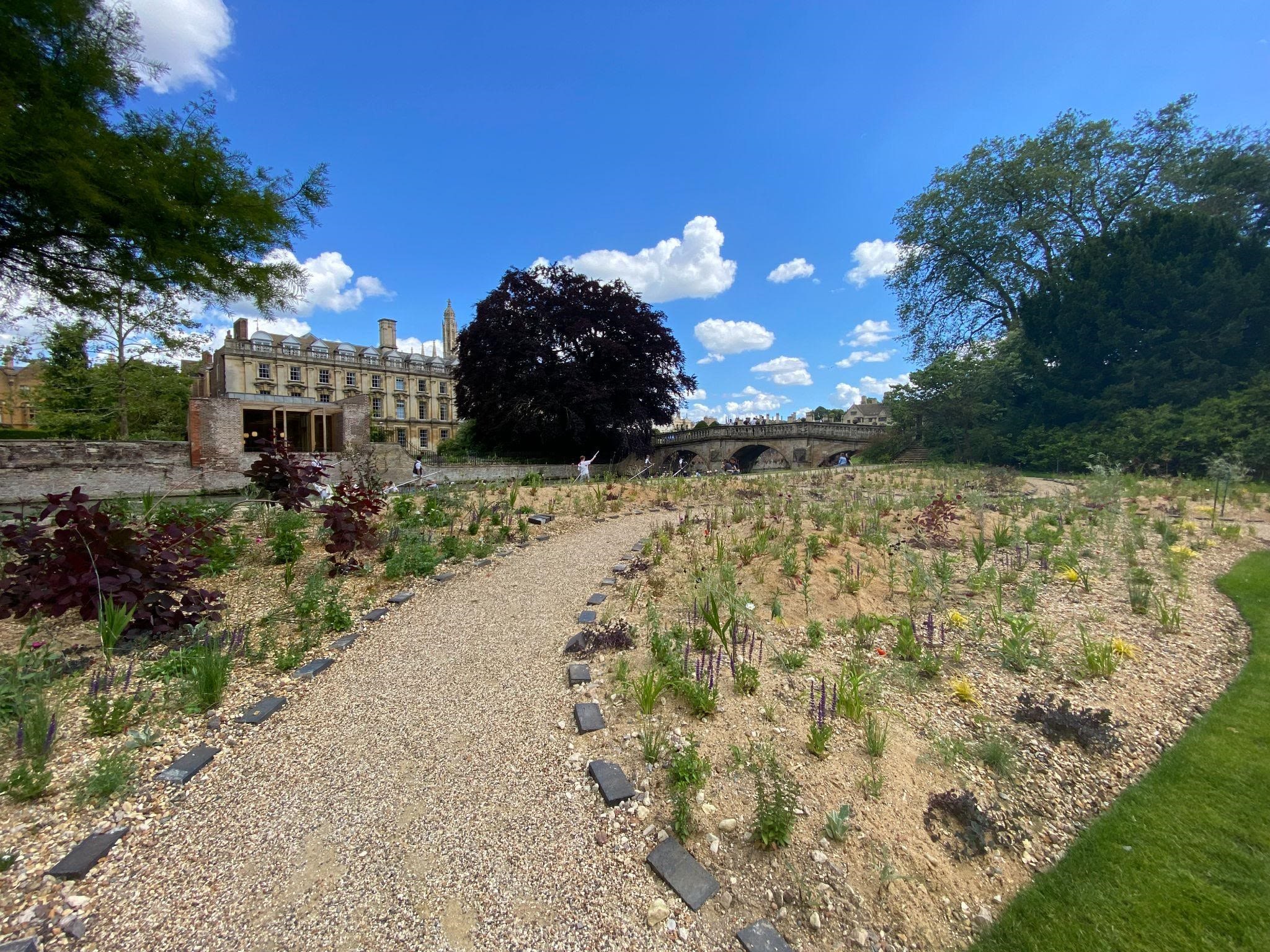

1. River Beds Dry Border
This is the new River Beds Dry Border, which exemplifies a modern and sustainable ethos to gardening. The building of the River Room Café presented an opportunity to re-think the previous resource-heavy Victorian-style river beds, where annual displays were changed twice a year. As climate change makes our summers hotter and drier, we opted for a more drought-tolerant scheme with a focus on biodiversity and wildlife needs.
We recycled and crushed leftover building materials to use as our planting medium, including some original bricks which couldn’t be reused in the new build. Planted within this medium are hardy perennials that will stay in all year round, creating not just structure in the beds but habitat for all manner of creatures. There are also annuals that will be allowed to self-set, forever continuing their lifecycle. The mounds of sand and gravel you see also give extra habitat to increase the biodiversity in the area. Once established, this riverbed will not need watering or fertiliser, and will require less input from the gardening team and the environment.
2. Swamp Cypress
This tree has been part of the Clare Gardens since it was planted in the early 1900s. Commonly known as the Swamp Cypress, this tree is native to the southeastern United States and is one of only a few deciduous conifer trees. Swamp Cypress’ are typically found in swamps or at the water’s edge, due to their ability to adapt to fluctuating water levels. This is because of its pneumatophores, an interesting adaptation which produces woody projections (also known as breathing knees) to provide oxygen to the roots below the water level. Until recently, it was a champion tree on the Tree Register of Britain and Ireland (TROBI) for its height. Unfortunately, in September 2020, we lost the top quarter of it in a storm, but that hasn’t stopped it from being a favourite spot for students to enjoy the river bed.
Swamp Cypress, photo taken November 2015
Swamp Cypress, photo taken November 2015
3. Ohio Buckeye Chestnut
This tree surprised the gardening team in 1945/46 when it volunteered itself to be part of Clare. Although this tree is Native to North America, it was discovered as a sapling–likely planted by a squirrel or bird–during the general clearance of the gardens to implement Nevill Willmer’s current design. The team elected to leave the sapling where it was, and as it grew, it would act as a focal point at the end of the river beds. Years later, it is still a garden favourite as it is always the first tree to turn and show its fantastic autumn colours.
4. Dawn Redwood
This hidden gem is the sole living species of the genus Metasequoia, one of the few deciduous conifer trees. A gift to the College, the tree was planted here in 1948. It was grown from seed collected on an expedition to China. It had previously only been known through fossil evidence and was thought to have been extinct for the last 5 million years. This tree was last measured in 2019 by the Tree Register of Britain and Ireland (TROBI) with a height of 24.5m and girth of 5.27m. This makes it the British, English and Cambridge champion tree in girth, and amongst the tallest in the country.
5. Lens Gate & vistas
The “lens gate” was designed by Wendy Ramshaw, funded in part by a bequest in Nevill Willmer’s will and was installed in November 2008.
The gate has a central lens, which gives a wider, almost panoramic, view of the Fellows Garden beyond. The fish-eye lens is one of many “vistas” into the Fellows Garden.
Nevill Willmer incorporated several “vistas” into his design where the Fellows Garden could be observed from specific viewpoints. These include the entrance from the “Tunnel of Gloom” by the Lawson Cypress, looking down towards the river; the Masters Garden looking across the river and back towards the Lawson Cypress; gazing down onto the river beds from the bridge; the avenue’s central steps and lens gate; and views of the mixed border from the avenue through the ‘windows’ cut in the flanking vegetation.
The opening of the River Café has created yet another vista and arguably one of the best in the College of the new dry border scheme in the riverbeds. Framed by the oak pergola, one enjoys the panoramic view across the river to the dry borders, catching a glimpse of the end of the Yellow & Blue border just beyond the Swamp Cypress.
6. Yellow & Blue Border
This cheery border is part of the garden redesign by Nevill Willmer after the Second World War. Only yellow and blue colour this border to highlight one aspect of Willmer’s research: how the brain perceives colour through changing light. At twilight, you will notice the blues become lighter and the yellows darker as daylight wanes, and members of Clare have gathered to watch this very effect for years.
Although the colors are limited to yellow and blue, below you can find the rich variety of planting that makes up the double border:
Delphinium
Delphinium
Achillea, Rudbeckia and sweet peas
Achillea, Rudbeckia and sweet peas
Thalictrum flavum glaucum
Thalictrum flavum glaucum
Anchusa ‘Loddon Royalist’
Anchusa ‘Loddon Royalist’
Bearded iris & Anchusa
Bearded iris & Anchusa
Rosa ‘Golden Showers’
Rosa ‘Golden Showers’
7. Mixed Border
This seemingly endless herbaceous perennial border sweeps the entire length of the Fellow’s Garden Lawn. It provides a colourful focal point from along the Avenue, the Master's Lodge, the Bridge and the River Café. The original planting design was hit very hard during the COVID pandemic when it suffered from overgrown weeds during lockdown and subsequent building works. The entire border has since been dug, hand weeded (to avoid using chemicals for weed control), and replanted with a vibrant new planting which will mature over the proceeding years. This design allows gardeners to experiment with whatever colour combinations they desire on this border, so you can expect a riotous smorgasbord of colours from late spring to autumn. A current favourite plant for many of the gardening team is Echinops bannaticus/Globe Thistle ‘Blue Globe’ for its beautiful, spherical blue flower heads.
8. Tropical Garden
The Tropical Garden has had a few iterations and remains a garden in transition. Under Wilmer’s design, this area became a scented garden, and some of his original shrubs can still be seen (and smelled) today[1] [2] . However, the garden had another transformation under the previous Head Gardener, Steve Elstub, who opted for a ‘tropical style’ of planting which included banana plants, canna lilies & gingers. Some of the scented plants have been slowly phased out and replaced by more suitable planting to the gardens name, towards big leaved tropical-esque plants such as Trachycarpus fortunei (Chusan palm), Paulownia tormentosa & Colocasia esculenta. Three fantastic Foxglove Trees (Paulownia Tormentosa)[3] can be found around the edge of the garden.
Since this garden is a natural frost pocket, all tender perennials are lifted each year before the winter frosts and stored in the greenhouse. Depending on the time of year, you might see bananas left in situ protected with straw and horticultural fleece. The whole garden is then planted out again in May. In an effort to move towards more sustainable planting, those tropical plants that do not survive hard frosts are not replaced but instead substituted with hardier, more suitable plants for this chilly part of the garden.
Cannas and Colocasias in the greenhouse
Cannas and Colocasias in the greenhouse
The Tropical Garden
The Tropical Garden
9. Sunken Garden
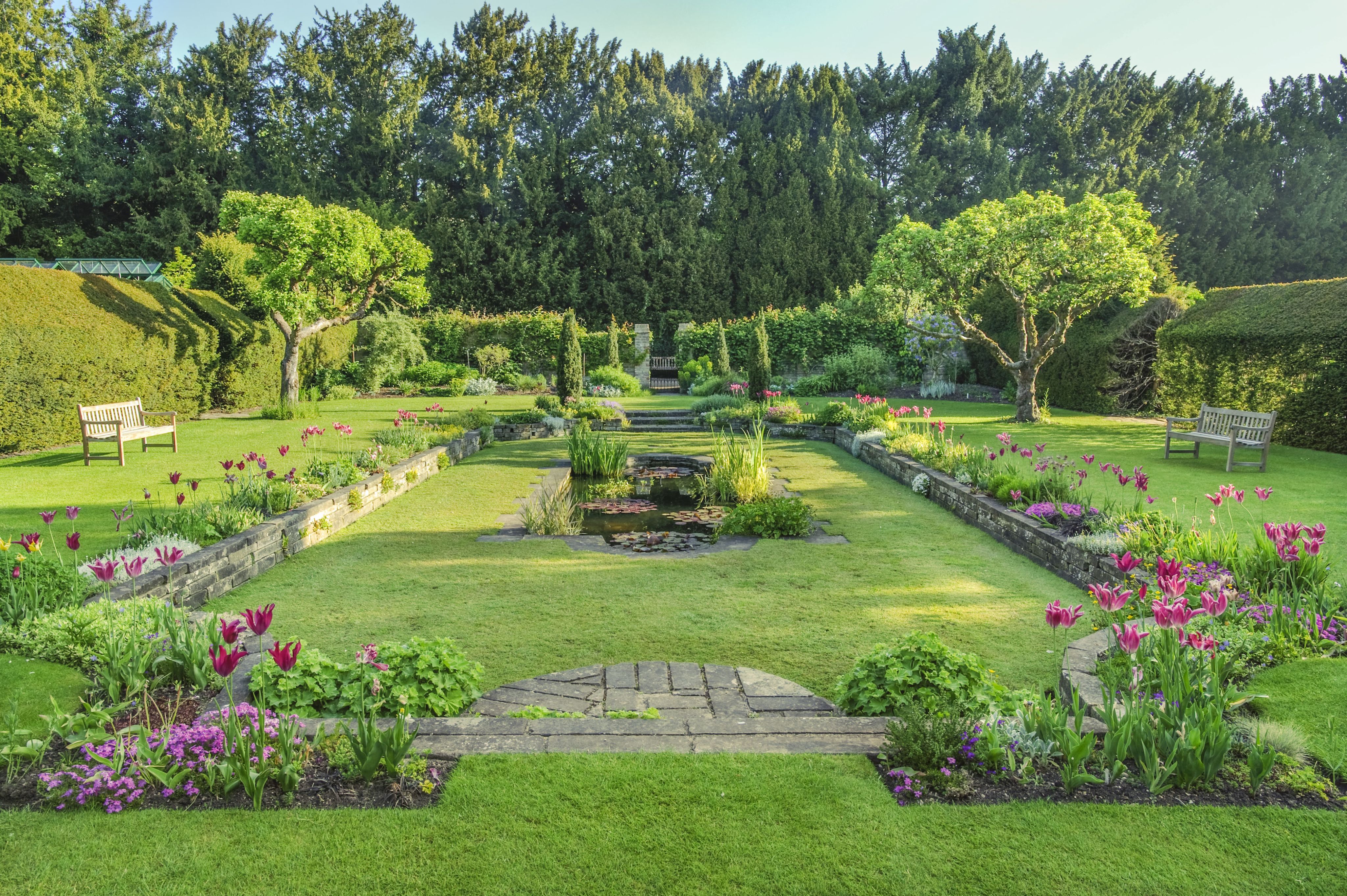

You have arrived in the beautiful Sunken Garden, the inner sanctum and beating heart that connects all parts of the garden. The axis for this garden runs north and south at right angles to the Yellow and Blue border which you can see through a gap in the hedge towards the river. The old Victorian wall boasts a pastel border and a gate leading you to the Dean’s Walk, which was developed as a serene space for the Dean to compose their sermons, full of white and cream flowers or variegated foliage. Directly opposite the Victorian gate, through the southern gap in the hedge and across the Fellow’s Lawn is the Lens Gate leading onto The Avenue.
The sunken pond in the centre, inspired by a visit to Pompeii in 1926, gives this garden its name. The water level in the pond is determined by the water table and the level of the River Cam itself. The encircling Yew hedge, anchored into an old Victorian wall, is shaped like the apse of a church or an outdoor theatre, which offers our Clare Actors a perfect setting for stage performances each spring.
Like many parts of Cambridge and Clare College, this garden contains living remnants of the past. Two gnarled and ancient apple trees stand as the sole survivors of an old orchard[2] [3] . While the species is unknown for one, we believe the other is Lord Derby. We can tell you that they are more cookers than eaters!
10. Scholars' Garden
The Scholars' Garden is very popular with the College community for events, be it drinks receptions, reunions or birthday parties.
The boundary wall with Kings College is said to be one of the oldest walls in Cambridge:
A ‘battlemented wall’ is referred to in a record of 1420, and it appears in Hammond’s Plan of 1592 running from the south-west corner of the court to the river. The lower stages of this wall still survive, separating Clare from Kings”- ref Sir Philip Dowson, graduate and Honorary Fellow of the College.
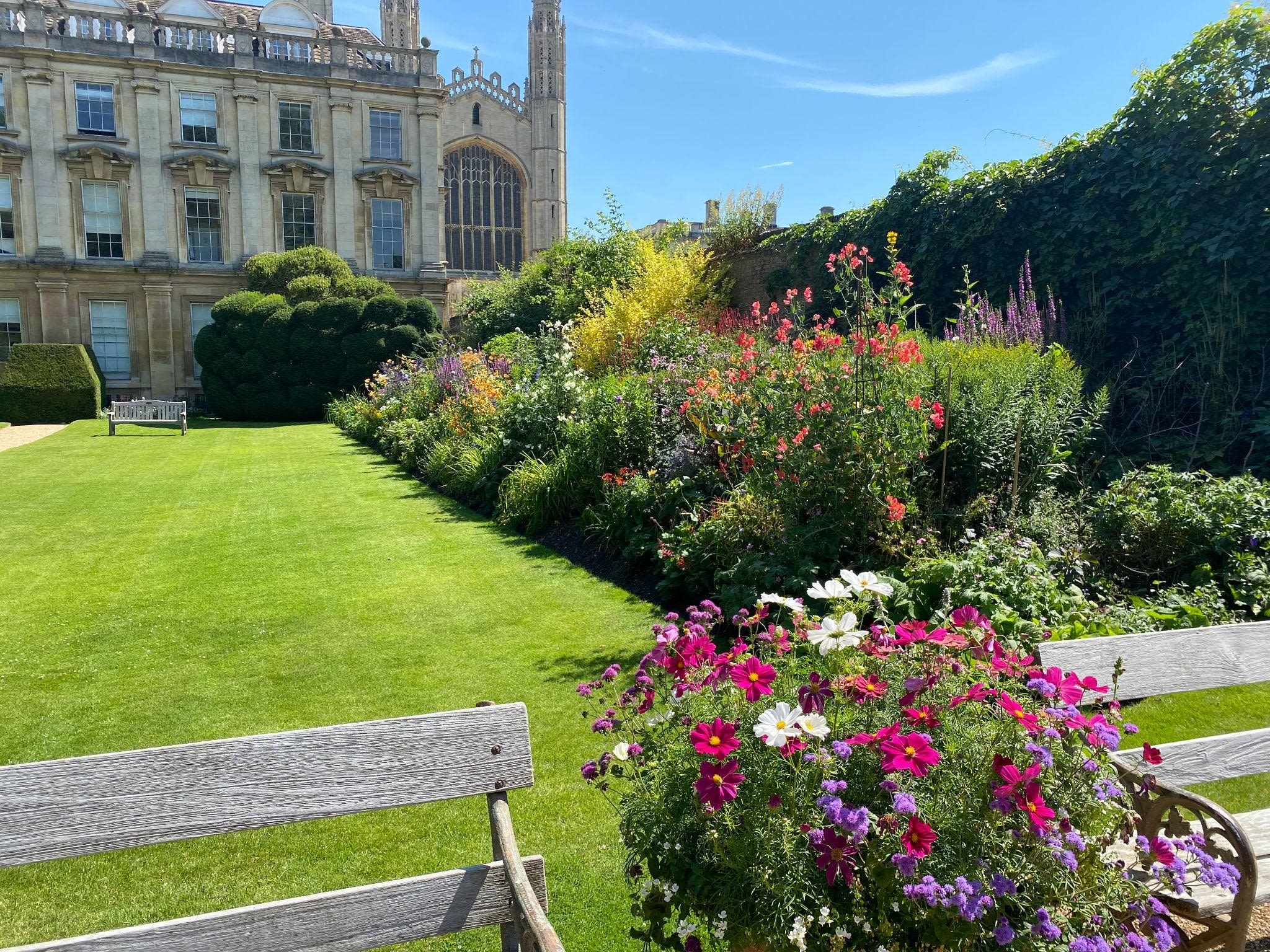
The long and wide mixed herbaceous border is flanked at the eastern side by a large Yew hedge and an ancient Buxus poking out over the top. In 2015 the decision was made to turn this large expanse of plain Yew hedge into something more interesting and the gardens team started cloud pruning shapes into it. It has proven popular with the students who now fondly refer to it as the “brain hedge.”
We'd love to know what you think of
the new QR codes, please share any
feedback below:
